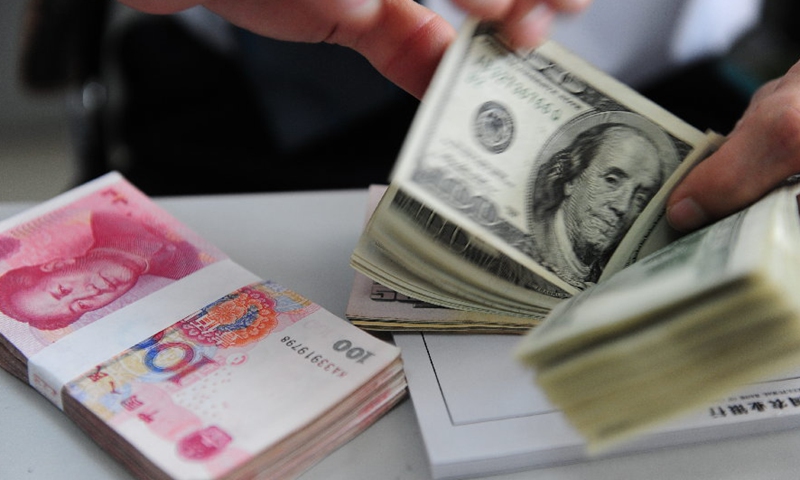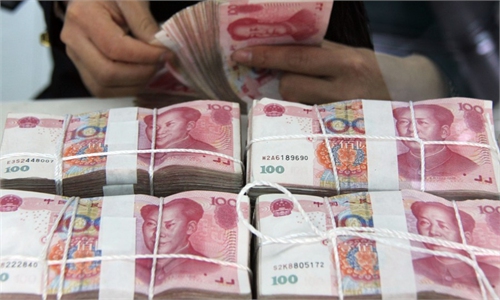Banks cut rates on dollar deposits in market-oriented move
Foreign media claims of government intervention 'untrue'

A teller counts U.S. dollar bills at a bank in Qionghai, south China's Hainan Province.Photo:Xinhua
Major Chinese state-owned banks lowered the caps on US dollar deposit rates this week, a market-oriented move in response to ample dollar deposits at Chinese banks and an anticipated end to US interest rate hikes, experts said.
They refute claims by some foreign media that the Chinese government had intervened in the exchange rate.
A manager at a Bank of China branch in Shanghai said that the one-year dollar deposit rate dropped from 5 percent to 4.3 percent starting from Monday for deposits above $50,000 and 2.8 percent for those under $50,000.
"The fluctuation of bank interest rates is normal and relatively frequent," the manager told the Global Times.
She expected that the deposit rate would be kept steady for some time but will follow a downward trend in the longer term, attributing the rate cut to a number of market variables such as volatile global interest rates and rising dollar deposits at the banks.
A manager of an Industrial and Commercial Bank of China (ICBC) branch in downtown Beijing confirmed to the Global Times that dollar deposit rates had been cut significantly, amid expectations of no more US interest rate hikes in the coming months.
For a deposit of $30,000, the rate was 4.8 percent on Sunday but only 2.8 percent on Monday.
In addition to the dollar deposits, a number of Chinese lenders also moved to reduce rates on yuan deposits.
A manager at a branch of Ping An Bank in Shanghai told the Global Times on Wednesday that the bank may lower the three-year yuan deposit rate to less than 3 percent from the current 3.25 percent, effective from next week.
Xi Junyang, a professor at the Shanghai University of Finance and Economics, said that Chinese banks have ample dollars and the need to offer high interest rates to attract deposits has weakened.
Anticipation for US interest rates to fall from their previous highs also gave room for Chinese banks to make the change, Xi said, noting that the move is market-oriented.
China's outstanding foreign currency deposits totaled $881.9 billion at the end of April, down 11.6 percent year-on-year, according to the People's Bank of China (PBC), the central bank.
Some bank insiders said that the rate changes for dollar deposits were a self-regulatory measure to maintain stability in the dollar-yuan exchange rate. The yuan has weakened more than 6 percent against the dollar since January.
The central bank set the mid-point rate of the yuan against the dollar at 7.1196 on Wednesday.
In May, the central bank pledged to curb speculation and wild fluctuations in the exchange rate, and it vowed to keep the yuan's value relatively stable at a reasonable equilibrium against the dollar.
Despite facing downward pressure, the yuan has recently fluctuated within a reasonable two-way range.
Experts expect the yuan to remain at a reasonable level against the dollar, supported by China's economic recovery, and the attractiveness of yuan assets in the long term.
Data from China's securities regulator showed that since the beginning of this year, foreign capital inflows have continued into the A-share market, with a net inflow of 170 billion yuan ($23.87 billion) through stock connects during the January-May period.
Statistics from the State Administration of Foreign Exchange (SAFE) show that as of the end of May, China's foreign exchange reserves amounted to $3.176 trillion, down $28.3 billion, or 0.88 percent, from the end of April.
China's economy has continued to recover and improve, which is conducive to maintaining the basic stability of the foreign exchange reserves, the SAFE said.


